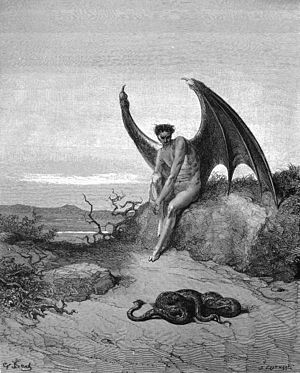p. 125
HENRIE STEPHEN, in A World of Wonders, published in 1607, mentions a monk of St. Anthony who declared that while in Jerusalem the patriarch of that city had shown him not only one of the ribs of the Word made flesh and some rays from the Star of Bethlehem, but also the snout of a seraph, a finger nail of a cherub, the horns of Moses, and a casket containing the breath of Christ! To a people believing implicitly in a seraph sufficiently tangible to have its proboscis preserved, the more profound issues of Judaistic philosophy must necessarily be incomprehensible. Nor is it difficult to imagine the reaction taking place in the mind of some ancient sage should he hear that a cherub–which, according to St. Augustine, signifies the Evangelists; according to Philo Judæus, the outermost circumference of the entire heavens, and according to several of the Church Fathers, the wisdom of God–had sprouted finger nails. The hopeless confusion of divine principles with the allegorical figures created to represent them to the limited faculties of the uninitiated has resulted in the most atrocious misconceptions of spiritual truths. Concepts well-nigh as preposterous as these, however, still stand as adamantine barriers to a true understanding of Old and New Testament symbolism; for, until man disentangles his reasoning powers from the web of venerated absurdities in which his mind has lain ensnared for centuries, how can Truth ever be discovered?
The Old Testament–especially the Pentateuch–contains not only the traditional account of the creation of the world and of man, but also, locked within it, the secrets of the Egyptian initiators of the Moses concerning the genesis of the god-man (the initiate) and the mystery of his rebirth through philosophy. While the Lawgiver of Israel is known to have compiled several works other than those generally attributed to him, the writings now commonly circulated as the purported sixth and seventh books of Moses are in reality spurious treatises on black magic foisted on the credulous during the Middle Ages. Out of the hundreds of millions of pious and thoughtful students of Holy Writ, it is almost inconceivable that but a mere handful have sensed the sublimity of the esoteric teachings of Sod (the Jewish Mysteries of Adonai). Yet familiarity with the three Qabbalistical processes termed Gematria, Notarikon, and Temurah makes possible the discovery of many of the profoundest truths of ancient Jewish superphysics.
By Gematria is meant not only the exchange of letters for their numerical equivalents but also the method of determining by an analysis of its measurements the mystic purpose for which a building or other object was constructed. S. L. MacGregor-Mathers, in The Kabbalah Unveiled, gives this example of the application of Gematria: “Thus also the passage, Gen. xviii. 2 VHNH SHLSHH, Vehenna Shalisha, ‘And lo, three men,’ equals in numerical value ‘ALV MIKAL GBRIAL VRPAL, Elo Mikhael Gabriel Ve-Raphael,’ These are Mikhael, Gabriel and Raphael; ‘for each phrase = 701.” Assuming the sides of a scalene to be 11, 9, and 6 inches, a triangle of such dimensions would then be an appropriate symbol of Jehovah, for the sum of its three sides would be 26, the numerical value of the Hebrew word IHVH. Gematria also includes the system of discovering the arcane meaning of a word by analyzing the size and arrangement of the strokes employed in the formation of its various letters. Gematria was employed by the Greeks as well as the Jews. The books of the New Testament–particularly those attributed to St. John–contain many examples of its use. Nicephorus Callistus declared the Gospel according to St. John to have been discovered in a cavern under the Temple at Jerusalem, the volume having been secreted “long anterior to the Christian æra.” The existence of interpolated material in the fourth Gospel substantiates the belief that the work was originally written without any specific reference to the man Jesus, the statements therein accredited to Him being originally mystical discourses delivered by the personification of the Universal Mind. The remaining Johannine writings–the Epistles and the Apocalypse–are enshrouded by a similar veil of mystery.
By Notarikon each letter of a word may become the initial character of a new word. Thus from BRASHITH, first word in the book of Genesis, are extracted six words which mean that “in the beginning the Elohim saw that Israel would accept the law.” Mr. MacGregor-Mathers also gives six additional examples of Notarikon formed from the above word by Solomon Meir Ben Moses, a mediæval Qabbalist. From the famous acrostic ascribed to the Erythræan Sibyl, St. Augustine derived the word ΙΧΘΥΣ, which by Notarikon was expanded into the phrase, “Jesus Christ, Son of God, Savior.” By another use of Notarikon, directly the reverse of the first, the initial, last, or middle letters of the words of a sentence may be joined together to form a new word or words. For example, the name Amen, ἁμήν, maybe extracted from ארנימלרנאטז, “the Lord is the faithful King.” Because they had embodied these cryptic devices in their sacred writings, the ancient priests admonished their disciples never to translate, edit, or rewrite the contents of the sacred books. .

Moe is the founder of GnosticWarrior.com. He is a father, husband, author, martial arts black belt, and an expert in Gnosticism, the occult, and esotericism.








![The Serpent entwined round an [Orphic] Egg referred to the creation of the Universe Ouroboros](https://www.gnosticwarrior.com/wp-content/uploads/2015/11/Ouroboros.jpg)